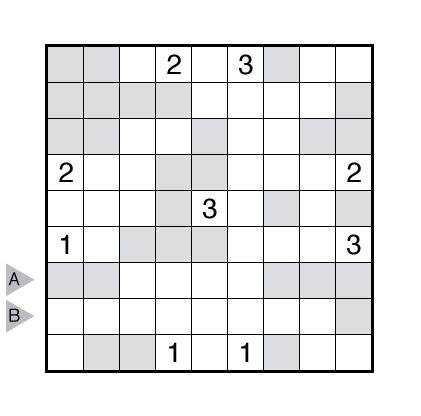This is a Melon puzzle. (21 – Neighbors)

or solve online (using our beta test of Penpa-Edit tools)
Theme: WPC Practice
Rules: Place a digit 1, 2, or 3 into each empty cell so that each digit appears exactly three times in each row and column. All cells are either white or gray. A digit in a white cell must share an edge with at least one cell containing the same digit. A digit in a gray cell cannot share an edge with any cell containing the same digit.
Answer String: Enter the digits from left to right in the marked rows, separating the rows with a comma.
Time Standards (highlight to view): Grandmaster = 10:00, Master = 15:00, Expert = 30:00
Solution: PDF

Beautiful. Thanks!
Nice logic !
It looks like what we call “trinaire puzzles”, see
.
But those miss the white cell rule.
I meant here…
Trinaire also showed up in the WPC (in a team round, so I didn’t practice it). Now having done both, I have to say that Neighbors is a whole lot more interesting as a type.
Hans added the white cell rule to Trinaire as he felt that would make them more interesting than they were on their own. That’s why they appeared in Breinbrekers like that from the start.
Fully agreed. Palmer did not write a practice Trinaire, but I doubt it would have made my editorial cut in comparison to this one.
Of course, one of the problems with Trinaire may be that, of all the examples I’ve seen and that’s not many, all gray cells start with given numbers. There is probably a better puzzle that just focuses on gray cells, with no white rule, that gives empty gray cells at the start too as clues. But not necessarily all cells that must be gray. It might be the all white/all gray nature of Neighbors has taken things too far, but Trinaire definitely feels too simplistic as it is currently presented.
I’m curious whether the time standards were based on testers who had seen this puzzle type (or a similar one) before, or whether they came in cold like I did. It took a bit of time just to figure out all the possible inferences in a puzzle like this — in fact I forgot the “three of each digit per row” rule until 10+ minutes into the solve…
This was either the first, second, or third puzzle of the style for the test-solvers. As with many newer variations timing is even harder to set for the style as most readers will have never seen the style before.